Analysis of applicability of method of aerosol particles permeability in porous materials for incoming control of filtering elements with nanostructured membranes used for liquids purification
Genady Vasilievich Grigoryev, Vitaly Vladimirovich Grigorov, Olga Vladimirovna Raskach and Ekaterina Pavlovna Zaloznaya
Joint Stock Company – State Scientific Centre of the Russian Federation – Institute for Physics and Power Engineering named after A.I. Leypunsky (JSC “SSC RF − IPPE”) Russia, 249033 Kaluga region, Obninsk, Bondarenko, 1
DOI : http://dx.doi.org/10.13005/ojc/31.Special-Issue1.05
Article Received on :
Article Accepted on :
Article Published : 06 Nov 2015
An incomplete extraction of uranyl ammonium tricarbonate (UATC) from mother solutions is one of the problems concerning liquid radwaste accumulation. Implementation of processes and devices allowing for complete extraction of residual UATC from mother solutions would make it possible to significantly decrease expenses by the plant for radwaste utilization and environmental impact, and also to return UATC to the fuel production process. Update of mother solution handling technology is attributed in particular to the development and implementation of liquids purification systems using membranes. Successful introduction of membrane purification systems to the plants is primarily related to the quality of the membranes and the possibility of their total (100%) quality control. This paper represents the analysis of the possibility of using method based on aerosol particles permeability in porous materials as total incoming control of filtering elements with nanostructured membranes designed for removal of mechanical impurities from liquids [1, 2]. Analysis of this method was made in the following steps:
- measurement of the total number of particles and initial spectrum of aerosol particles;
- measurement of the total number of particles and spectra of aerosol particles transmission through porous base coats produced in various agglomeration modes;
- measurement of the total number of particles and spectra of aerosol particles transmission through the filtering elements with Ti – nano-membrane;
- calculation of coefficient of aerosol particles capture by Ti – membrane;
- evaluation of filtering elements quality.
uranyl ammonium tricarbonate (UATC); mother solutions; purification; nanostructured membranes; aerosol particles; filtering element; the porous substrate
Download this article as:| Copy the following to cite this article: Grigoryev G. V, Grigorov V. V, Raskach O. V, Zaloznaya E. P. Analysis of applicability of method of aerosol particles permeability in porous materials for incoming control of filtering elements with nanostructured membranes used for liquids purification. Orient J Chem 2015;31(Special Issue1). |
| Copy the following to cite this URL: Grigoryev G. V, Grigorov V. V, Raskach O. V, Zaloznaya E. P. Analysis of applicability of method of aerosol particles permeability in porous materials for incoming control of filtering elements with nanostructured membranes used for liquids purification. Orient J Chem 2015;31(Special Issue1). Available from: http://www.orientjchem.org/?p=12286 |
Introduction
To date, the share of nuclear power in the global energy production is steadily growing, and this growth rate strongly depends on the rate of increase of uranium mining and fuel production. Now the attention is being increasingly focused on the improvement of energy performance and safety of industrial production of uranium compounds and further uranium fuel fabrication.
In addition, there is a problem concerning accumulation and storage of liquid radwaste, which is primarily caused by incomplete extraction of uranyl ammonium tricarbonate (UATC) from mother solutions. Implementation of processes and devices allowing for complete extraction of residual UATC from mother solutions would make it possible to significantly decrease expenses by the plant for radwaste utilization and environmental impact, and also to return UATC to the fuel production process [3, 4].
Mother solution handling technique can be improved using membrane technology of liquids purification developed by the JSC “SSC RF – IPPE”. This technology entails the use of filtering elements with nanostructured metallic or ceramic membranes (made of titanium, zirconium, chromium etc. or their oxides, carbides and nitrides) [1, 2]. Hydrodynamics of liquid flow purified by the membrane filtering depends on the structure and composition of porous composite pair: “nanostructured membrane – base coat”. The lack of the total control of the composite pair may cause decrease of product quality and, as a result, the abrupt decrease of available period of stable filtration of mother solutions, decrease of filtering system lifetime or rapid rupture of porous materials. Complete quality evaluation of composite pair and nanostructured membrane by the standard methods (microscopic investigation, hydrodynamic performance check, structural analysis etc.) is time-consuming and cost-intensive procedure causing considerable increase of filtering material cost. In this view, it is viable to consider the possibility of using evaluation of spectra of aerosol particles penetrating through filtering element as a method of control of membrane filtering elements with required working characteristics. Results of evaluation of aerosol particles comparative permeability can also be used for the incoming control of membrane filtering elements intended for removal of mechanical impurities from liquids [5,6,7].
Analysis of the possibility of using method based on aerosol particles permeability in porous materials for total incoming control of filtering elements with nanostructured membranes designed for removal of mechanical impurities from liquids was made in the following steps:
- measurement of the total number of particles and initial spectrum of aerosol particles;
- measurement of the total number of particles and spectra of aerosol particles transmission through porous base coats fabricated in various agglomeration modes;
- measurement of the total number of particles and spectra of aerosol particles transmission through the filtering elements with Ti – nanomembrane;
- calculation of coefficient of aerosol particles capture by Ti – membrane;
- evaluation of quality of filtering elements with Ti – nanomembrane [8].
Method
As a rule, at the stages of development and startup of production of filtering elements for liquids purification, selective control of their quality is performed using hydraulic characteristic Q = f(∆Р), where ∆P = P1 – P2, P1 – pressure at the membrane filter inlet, P2 – pressure at the membrane filter outlet, Q – liquid flow rate in the filter [3]. In order to eliminate the effect of impurities layer formed in the course of filtering on hydraulic characteristic Q = f(∆Р) to be determined, liquid containing no impurities (distillate) is commonly used. However the use of this method for the total quality control is complicated by the design features of test equipment and duration of drying of tested filtering elements.
Advantages of method of incoming control of filtering elements using parameter of aerosol particles penetrability are fast response, accuracy, capability of gaining significant amount of statistical data, reliability of results etc.
Work on evaluation of aerosol particles penetrability through the filtering elements with nanostructured membrane was carried out taking into account the following technological characteristics:
- modes of porous base coats fabrication [9,10];
- modes of formation of plasma-chemical membranes on porous polymer base coat.
The use of low pressure ultrahigh-molecule polyethylene (LP UHMWPE) powder was required for base coat in order to meet the following requirements:
- min grain-size dispersion of the composition to assure max uniformity of through pores;
- min adhesion to the impurities in purified liquid;
- high softening temperature of agglomerated porous material.
Taking into account these requirements GUR 4120 powder (Germany) was used, its technical characteristics being as follows:
- molecular mass: within the range of 1∙106 – 8∙106 g/mole;
- average particle size: 50 – 180 µm;
- pour density: 380 – 480 g/L;
- ash content in terms of titanium: ~ 3ppm.
Formation of plasma-chemical Ti-membrane on LP UHMWPE porous polymer base coat was carried out in UNM vacuum facility (Figure 1).
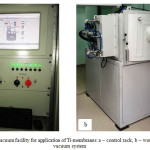 |
Figure 1: UNM vacuum facility for application of Ti-membranes: a – control rack, b – working chamber with vacuum system |
The volume of filtering elements for the analysis of aerosol particles penetrability spectra in this study was only determined by the parameters of porous base coats fabrication process. The mode of formation of plasma-chemical Ti-membrane on the porous base coat is settled. Parameters of control of the process of Ti-membrane application on porous polymer base coats are shown in mnemonic diagram (Figure 2).
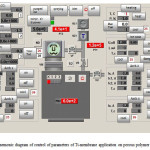 |
Figure 2: Mnemonic diagram of control of parameters of Ti-membrane application on porous polymer base coat |
Since all Ti-membranes were applied by the same technology, so the parameters of porous base coat fabrication process were the key determinants of aerosol particles permeability spectrum. The main parameters of porous base coat fabrication process are as follows: time of vibropacking of polymer powder in mold, and temperature and duration of agglomeration process [11, 12]. The total number of filtering elements with nanostructured membranes and porous base coats fabricated in various modes presented for the analysis of aerosol particles permeability spectra was 34.
The total number of particles and their spectra were measured using equipment shown in Figure 3.
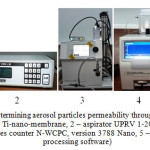 |
Figure 3: Equipment for determining aerosol particles permeability through the filtering element (1 – porous base coat or filtering element with Ti-nano-membrane, 2 – aspirator UPRV 1-20, 3 – electrostatic sorting machine, version 3080, 4 – aerosol particles counter N-WCPC, version 3788 Nano, 5 – computer with measurement data processing software) |
In Figure 4 presented is aerosol particles distribution spectrum typical for atmospheric air. Concentration of aerosol particles within the range of 27 nm – 947 nm (C0) registered by N-WCPC counter (version 3788 Nano) is 3.4·107 particles/cm3.
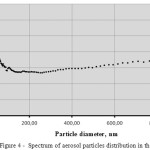 |
Figure 4: Spectrum of aerosol particles distribution in the air |
The basic criterion for evaluation of filtering elements quality using aerosol particles permeability method is integral permeability coefficient determined as the percentage ratio of the number of aerosol particles penetrated through the filtering element to the total number of aerosol particles in the air К = (Ci/C0)·100, expressed in percent. Another criteria of filtering elements incoming control is integral coefficient of aerosol particles capture by nanostructured membrane, determined as percentage ratio of the number of aerosol particles penetrated through the filtering element with applied nanostructured membrane to the number of aerosol particles penetrated through the corresponding porous base coat, К′ = (1 – Cмем/Cподл)·100, expressed in percent. Comparison of these coefficients to the function of impurities capture by the filtering element in the course of liquids purification would make it possible to adequately determine whether some failure occurred in the filtering elements fabrication process and, if so, at what stage this failure occurred [13,14,15].
Results and Discussion
Evaluation of porous base coat quality
Table 1 gives the numbers of aerosol particles penetrated through the filtering element and corresponding porous base coat. Concentration of aerosol particles in the initial spectrum is C0 = 3.4·107 particles/cm3.
It can be seen from Table 1 that max specific number of aerosol particles penetrated through the porous base coat corresponds No. 19 specimen and is equal to Ccoat = 3809 particles/cm3, while min specific number corresponding to No. 23 specimen is equal to 385 particles/cm3. Integral permeability coefficients of porous base coats of No. 19 and No. 23 specimens are equal, respectively, to Кcoat = (3809/3,4·107)·100 = 11,20·10-3 % и Кcoat= (385/3,4·107)·100 = 1,13·10-3 %. The difference between max and min values of integral permeability coefficients of porous base coats are of the same order and, hence, one can conclude that fabrication mode of No. 23 base coat is most close to optimum. The least integral permeability coefficient of filtering element is Кmem = (106/3,4·107)·100 = 0,31·10-3 % (No. 18 specimen).
In order to find the most preferable modes of porous base coat fabrication, taking into account the above considerations, the average min value of integral permeability coefficients for porous base coats and filtering elements can be calculated, its dispersion being within 40 % [16].
Table 1: Integral permeability coefficients for porous base (Kcoats) and filtering elements (Kmem)
|
No. |
Ccoat, particles/cm3 |
Cmem, particles/cm3 |
Кcoat, ·10‑3, % |
Кmem, ·10‑3, % |
No. |
Ccoat, particles/cm3 |
Cmem, particles/cm3 |
Кcoat, ·10‑3, % |
Кmem, ·10‑3, % |
|
1 |
1280 |
265 |
3,76 |
0,78 |
2 |
2294 |
845 |
6,75 |
2,49 |
|
3 |
1350 |
303 |
3,97 |
0,89 |
4 |
1261 |
658 |
3,71 |
1,94 |
|
5 |
1181 |
360 |
3,47 |
1,06 |
6 |
1751 |
986 |
5,15 |
2,90 |
|
7 |
957 |
333 |
2,81 |
0,98 |
8 |
683 |
368 |
2,01 |
1,08 |
|
9 |
875 |
620 |
2,57 |
1,82 |
10 |
2136 |
445 |
6,28 |
1,31 |
|
11 |
1349 |
288 |
3,97 |
0,85 |
12 |
3127 |
178 |
9,20 |
0,52 |
|
13 |
1166 |
367 |
3,43 |
1,08 |
14 |
936 |
312 |
2,75 |
0,92 |
|
15 |
1050 |
301 |
3,09 |
0,89 |
16 |
988 |
389 |
2,91 |
1,14 |
|
17 |
905 |
613 |
2,66 |
1,80 |
18 |
652 |
106 |
1,92 |
0,31 |
|
19 |
3809 |
779 |
11,20 |
2,29 |
20 |
868 |
184 |
2,55 |
0,54 |
|
21 |
745 |
136 |
2,19 |
0,40 |
22 |
1008 |
270 |
2,96 |
0,79 |
|
23 |
385 |
210 |
1,13 |
0,62 |
24 |
1904 |
763 |
5,60 |
2,24 |
|
25 |
1034 |
301 |
3,04 |
0,89 |
26 |
800 |
125 |
2,35 |
0,37 |
|
27 |
832 |
112 |
2,45 |
0,33 |
28 |
3797 |
631 |
11,17 |
1,86 |
|
29 |
1264 |
213 |
3,72 |
0,63 |
30 |
1365 |
455 |
4,01 |
1,34 |
|
31 |
1048 |
280 |
3,08 |
0,82 |
32 |
1359 |
594 |
4,00 |
1,75 |
|
33 |
1408 |
1068 |
4,14 |
3,14 |
34 |
1563 |
1044 |
4,60 |
3.07 |
|
Cinit.=3.4·107 particles/cm3 |
|||||||||
Average min value of integral permeability coefficient for porous base coat is 1,85·10-3 %. Taking into account the above dispersion (40 %) Nos. 23, 18, 8, 21, 26, 27, 20 and 9 specimens correspond to this value. For filtering element with Ti – membrane, the average min value of integral permeability coefficient is 0,47·10-3 %, to which Nos. 18, 27, 26, 21, 12, 20, 23 and 29 specimens correspond within stated 40 % range: 6 out of 8 specimens, i.e. 75 % were fabricated in the similar modes. For Nos. 23, 27, 18, 20, 21 and 26 specimens, dispersion of values of polymer powder vibropacking time in the mold, and temperature and duration of agglomeration process is within 5%.
Evaluation of nanostructured membrane quality
In Figures 5 and 6 presented are the most typical spectra of distribution of aerosol particles penetrated through porous base coat and filtering element.
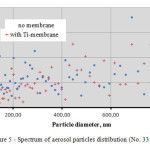 |
Figure 5: Spectrum of aerosol particles distribution (No. 33 specimen) |
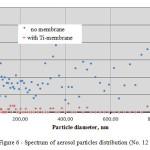 |
Figure 6: Spectrum of aerosol particles distribution (No. 12 specimen) Click here to View figure |
Analysis of spectra of distribution of aerosol particles penetrated through porous base coat and filtering element shows that the degree of aerosol particles capture by the nanostructured membranes applied in the similar mode varies within the wide range depending on the modes of porous base coat fabrication. This can be evaluated using integral coefficient of aerosol particles capture by nanostructured membrane (К′). In Table 2 presented are calculated К′ values.
Table 2: Integral coefficients of aerosol particles capture by nanostructured membrane (К′)
|
No. |
Ccoat, particles/cm3 |
Cmem, particles/cm3 |
К′, % |
No. |
Ccoat, particles/cm3 |
Cmem, particles/cm3 |
К′, % |
| 1 |
1280 |
265 |
79,3 |
2 |
2294 |
845 |
63,1 |
| 3 |
1350 |
303 |
77,6 |
4 |
1261 |
658 |
47,8 |
| 5 |
1181 |
360 |
69,5 |
6 |
1751 |
986 |
43,7 |
| 7 |
957 |
333 |
65,2 |
8 |
683 |
368 |
46,1 |
| 9 |
875 |
620 |
29,1 |
10 |
2136 |
445 |
79,2 |
| 11 |
1349 |
288 |
78,7 |
12 |
3127 |
178 |
94,3 |
| 13 |
1166 |
367 |
68,5 |
14 |
936 |
312 |
66,7 |
| 15 |
1050 |
301 |
71,3 |
16 |
988 |
389 |
60,6 |
| 17 |
905 |
613 |
32,3 |
18 |
652 |
106 |
83,7 |
| 19 |
3809 |
779 |
79,5 |
20 |
868 |
184 |
78,9 |
| 21 |
745 |
136 |
81,8 |
22 |
1008 |
270 |
73,3 |
| 23 |
385 |
210 |
45,5 |
24 |
1904 |
763 |
59,9 |
| 25 |
1034 |
301 |
70,6 |
26 |
800 |
125 |
84,4 |
| 27 |
832 |
112 |
86,5 |
28 |
3797 |
631 |
83,4 |
| 29 |
1264 |
213 |
83,2 |
30 |
1365 |
455 |
66,7 |
| 31 |
1048 |
280 |
73,3 |
32 |
1359 |
594 |
56,3 |
| 33 |
1408 |
1068 |
24,2 |
34 |
1563 |
1044 |
33,2 |
|
Cinit.=3.4·107 particles/cm3 |
|||||||
As follows from Table 2, values of integral coefficient of aerosol particles capture by nanostructured membrane are between К′min = 24,2 % (No. 33 specimen) and К′max = 94,3 % (No. 12 specimen). For specimens 23, 27, 18, 20, 21 and 26 selected on the basis of integral permeability, coefficient К′ value is ranging from 45,5 % to 86,5 %. Only one out of six specimens under consideration provides К′ value beyond 10% deviation from the averaged value.
Proceeding from stated filtration rates by porous base coat (~ 3 µm) and filtering element (~ 0,2 µm), ~ 93,3 % average value of nanostructured membrane contribution to the effectiveness of liquids purification is obtained by calculation. Therefore, method of filtering elements quality evaluation on the basis of aerosol particles permeability requires integral capture coefficient К′ to be equal to at least 93,3 %. Out of all fabricated specimens, only No. 12 meets this criterion. Hence, No.12 specimen porous base coat fabrication mode is most preferable for the stated mode of nanostructured membrane application.
Comparison of capture coefficients (water and air)
In Table 3, presented are min, medium and max values of coefficient of air purification by the filtering element Кair = (100 – Кmem) and coefficients of iron removal from water (КFe) obtained experimentally for the corresponding specimens.
Table 3: Coefficients of air purification (Кair) and iron removal from water by filtering elements (КFe)
|
No. of specimen |
Кair, % |
КFe, % |
|
33 |
99,99686 |
2,2 |
|
32 |
99,99825 |
49 |
|
26 |
99,99963 |
54,1 |
Figure 7 shows the relationship between the coefficients of air purification and those of iron removal from water by the filtering elements. As it follows from Table 3 and Figure 7, there is correlation dependence between Кair and КFe coefficients. Therefore, with a knowledge of air purification coefficient value, one can estimate with a reasonable degree of accuracy the quality of filtering elements used for liquids purification, as well as detect filtering element fabrication stage in which fabrication technology failure occurred.
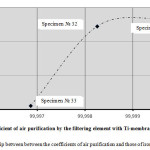 |
Figure 7: Relationship between between the coefficients of air purification and those of iron removal from water |
On the basis of analysis of obtained results the following technological procedures required for the further improvement of membrane filtering elements should be noticed:
- optimization of modes of nanostructured membrane application on the porous base coat in order to increase integral coefficient of aerosol particles capture by the membrane filtering element up to at least 93,3 % value;
- optimization of porous base coat fabrication technology within determined 40 % range of this technology parameters.
Conclusion
- Method based on aerosol particles penetrability in porous materials can be adequately applied to incoming control of filtering elements with nanostructured membranes designed for liquids purification
- Method of evaluation of membrane filtering element quality by measuring aerosol particles penetrability through this element includes recording and correction of all features of technological cycle of production of filtering element with nanostructured membrane to be used for purification of liquids including those containing uranium.
- Ranges of key parameters of porous base coat fabrication technology (time of polymer powder vibropacking in the mold, and temperature and duration of agglomeration procedure) were determined with dispersion not exceeding 5 %.
- Incoming quality control of membrane filtering element on the basis of aerosol particles capture coefficient of nanostructured membrane revealed the necessity for optimization of technology of nanostructured membrane formation on porous base coat.
- Method of estimation of aerosol particles penetrability in porous materials as incoming control of filtering elements with nanostructured membranes makes it possible to evaluate filtering element quality and also detect any failure of filtering element fabrication technology and the stage of fabrication, in which this failure occurred.
References
- Bakhurov V.G. In-situ leaching of uranium ores, Moscow, 1969.
- Brovin K.G., Grabovnikov V.A., Shumilin M. V., Yazikov V. G. The forecast, searches, investigation and an industrial assessment of fields of uranium for working off by underground leaching. Edition: Gylym, Almaty, 1997.
- Chemistry of industrial sewage, under the editorship of A. Rubin. Moscow, Chemistry, 1983.
- Grigoryev G.V., Martynov P.N. and Gulevsky V.A. // Filtering element and method of its fabrication. Patent No. 2148679, 2000.
- Impurities in water (data base) on http://maxville.ru/stati/primesi-v-vode
- Koshkolda K.N., Pimenov M. K., Atakulov T., etc. Ways of an intensification of underground leaching. M.: Energoatomizdat, 1988.
- Larin V.K., Zaitsev R.V., Experience of industrial application of heap leaching of uranium ores. Mining Journal, 1999. – № 12.
- Martynov P.N., Askhadullin R.Sh., Yagodkin I.V., Grigoryev G.V., Grigorov V.V. and Nizovtsev A.A. // New approaches to integrated purification of potable water. Clear water: problems and solutions. 2012 / No. 3–4.
- Martynov P.N., Smogalev I.P., Sotov M.I., Zinin A.I., Zinina G.A., Artemiev V.K. The calculation-experimental substantiation of perspective methods of liquid and gas purification from impurity particles. IPPE Preprint – 2051, 1995.
- Martynov P.N., Yagodkin I.V., Askhadullin R.Sh., Mel’nikov V.P., Skvortsov S.S., Posazhennikov A.M., Grigoryev G.V. and Grigorov V.V. // New class of nanostructured filtering materials in technologies of purification of liquids in NPP with VVER. Heavy Industry. Ed. No. 4. Moscow, 2010.
- Martynov P.N., Yagodkin I.V., Mel’nikov V.P., Grigoryev G.V. and Del’nov V.N., Membrane module for purification of liquid, Patent No. 2416459, Federal Institute of Industrial Property, 20.04.2011.
- Martynov P.N., Yagodkin I.V., Papovyants A.K., Mel’nikov V.P., Grishin A.G. and Smogalev I.P., Preliminary purification of natural waters by tangential filtering, Water Purification, 2013.
- Nesmeyanov A.N. Radiokhimiya. M. “Chemistry”, 1978.
- Nizovtsev A.A., Grigoryev G.V., Grigorov V.V., Purisov I.E. and Yagodkin I.V. // Production of high-porosity granulated material of low pressure ultrahigh-molecule polyethylene powder. New Technologies. Proceedings of VIII All-Russia Conference, Moscow, 2011.
- Sudarikov B.N. and Rakov E.G., Processes and equipment of uranium production works – Moscow: Mmechanical engineering, 1969,.
- Turayev N. S., Zherin I.I. Chemistry and technology of uranium. – M.: Ores and metals, 2006.

This work is licensed under a Creative Commons Attribution 4.0 International License.









